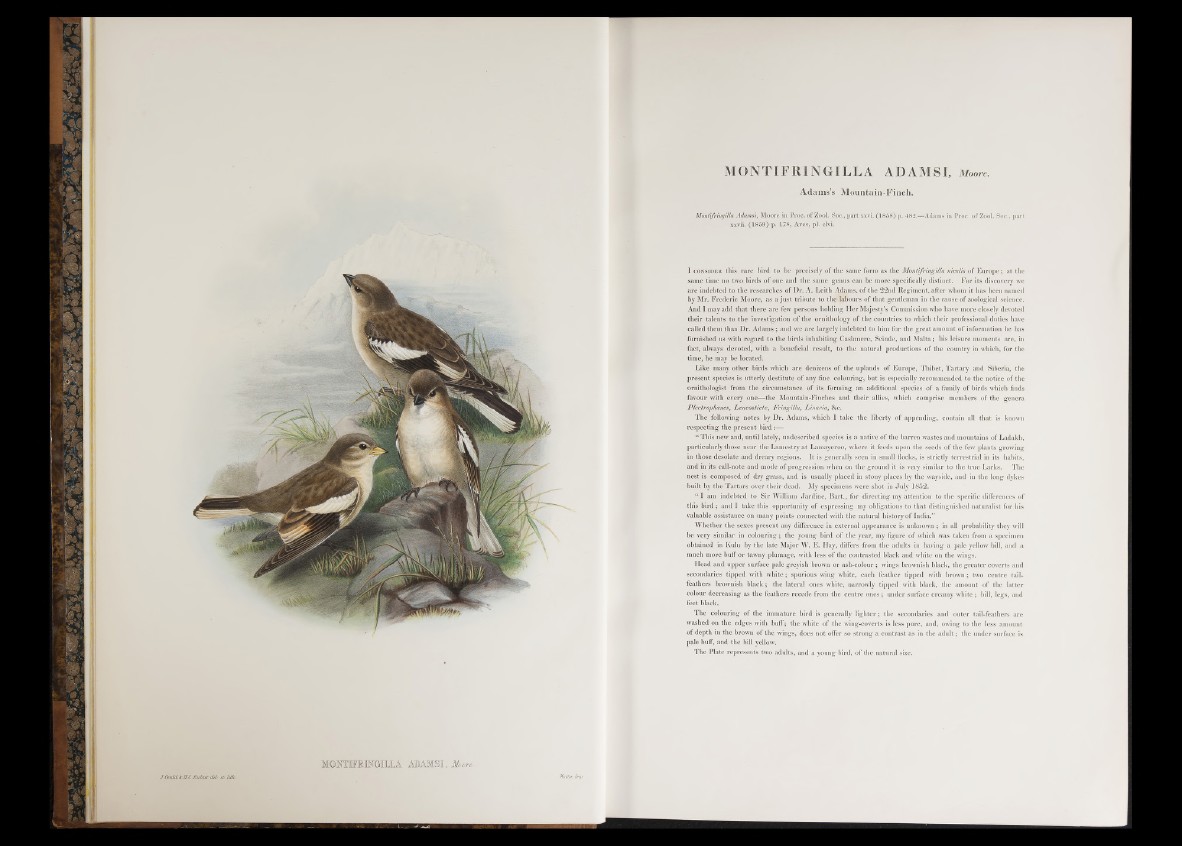
ITOHTH'EWGBLJLA ADAMSI. Moore,
MONTIFRINGILLA ADAMSI, Moore.
Adams’s Mountain-Finch.
Mmtifringilla Adamsi, Moore in Proc. of Zool. Soc., p a rt xxvi. (1858) p. 482.—Adams in Proc of Zool. Soc., part
xxvii. (1 859) p. 178, Aves, pi. clvi.
I c o n s i d e r this rare bird to be precisely of the same form as the M ontifringilla nivalis of Europe; at the
same time no two birds of one and the same genus can be more specifically distinct. For its discovery we
are indebted to the researches of D r. A. Leith Adams, o f the 22nd Regiment, after whom it has been named
by Mr. Frederic Moore, as a just tribute to the labours of that gentleman in the cause of zoological science.
And 1 may add that there are few persons holding Her Majesty’s Commission who have more closely devoted
their talents to the investigation of the ornithology of the countries to which their professional-duties have
called them than Dr. Adams ; and we are largely indebted to him for the great amount of information he has
furnished us with regard to the birds inhabiting Cashmere, Scinde, and Malta; his leisure moments are, in
fact, always devoted, with a beneficial result, to the natural productions of the country in which, for the
time, he may be located.
Like many other birds which are denizens o f the uplands of Europe, Thibet, Tartary and Siberia, the
present species is utterly destitute of any fine colouring, but is especially recommended to the notice of the
ornithologist from the circumstance of its forming an additional species of a family of birds which finds
favour with every one—the Mountain-Finches and their allies, which comprise members of the genera
Plectrophanes, Leucosticte, Fringilla, Linaria, &c.
The following notes by Dr. Adams, which I take the liberty of appending, contain all that is known
respecting the present bird:—
“ This new and, until lately, undescribed species is a native of the barren wastes and mountains of Ladakh,
particularly those near the Lamestry at Lamayeroo, where it feeds upon the seeds of the few plants growing
in those desolate and dreary regions. It is generally seen in small flocks, is strictly terrestrial in its habits,
and in its call-note and mode of progression when on the ground it is very similar to the true Larks. The
nest is composed o f dry grass, and is usually placed in stony places by the wayside, and in the long dykes
built by the Tartars over their dead. My specimens were shot in July 1852.
“ I am indebted to Sir William Jardine, Bart., for directing my attention to the specific differences of
this b ird ; and I take this opportunity of expressing my obligations to that distinguished naturalist for his
valuable assistance on many points connected with the natural history of India.”
Whether the sexes present any difference in external appearance is unknown ; in all probability they will
be very similar in colouring; the young bird of the year, my figure of which was taken from a specimen
obtained in Kulu by the late Major W. E. Hay, differs from the adults in having a pale yellow bill, and a
much more buff or tawny plumage, with less of the contrasted black and white on the wings.
Head and upper surface pale greyish brown or ash-colour; wings brownish black, the greater coverts and
secondaries tipped with white; spurious wing white, each feather tipped with brown; two centre tail-
feathers brownish black; the lateral ones white, narrowly tipped with black, the amount of the latter
colour decreasing as the feathers recede from the centre ones ; under surface creamy white ; bill, legs, and
feet black.
The colouring of the immature bird is generally lig h te r; the secondaries and outer tail-feathers are
washed on the edges with buff; the white of the wing-coverts is less pure, and, owing to the less amount
o f depth in the brown of the wings, does not offer so strong a contrast as in the ad u lt; the under surface is
pale buff, and the bill yellow.
The Plate represents two adults, and a young bird, of the natural size.